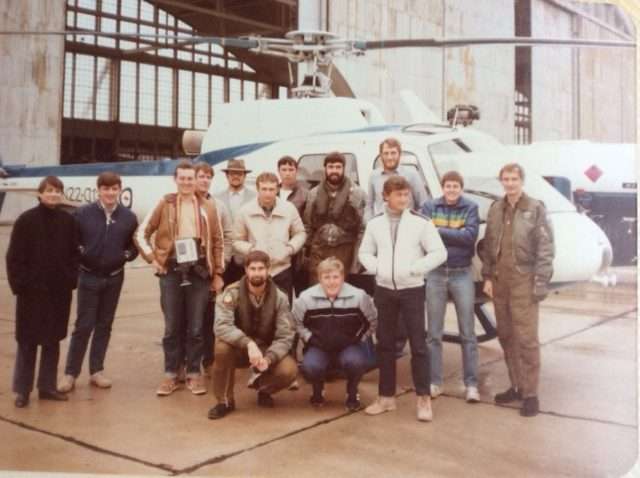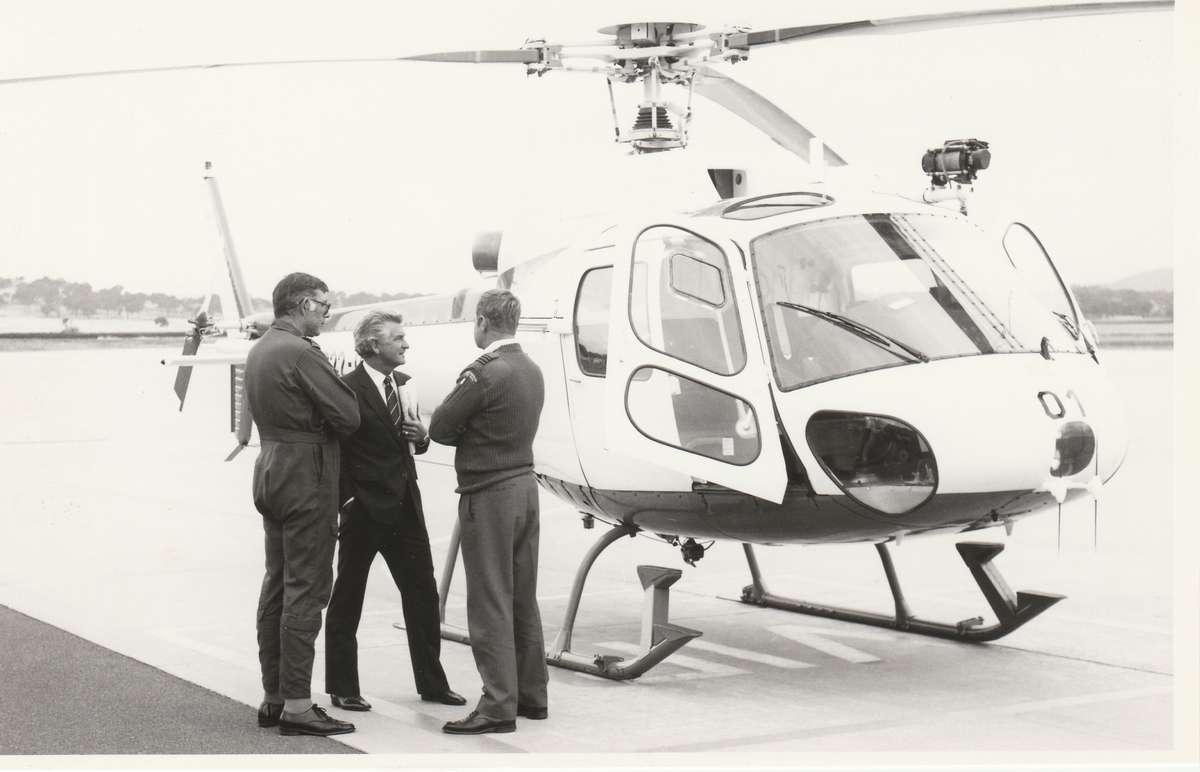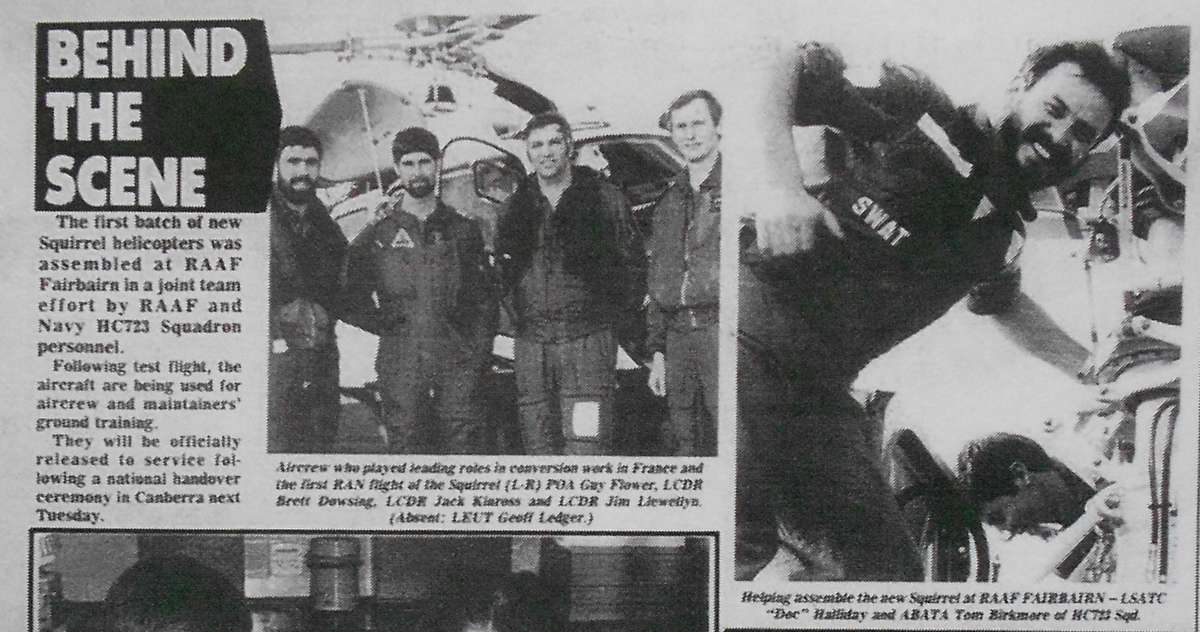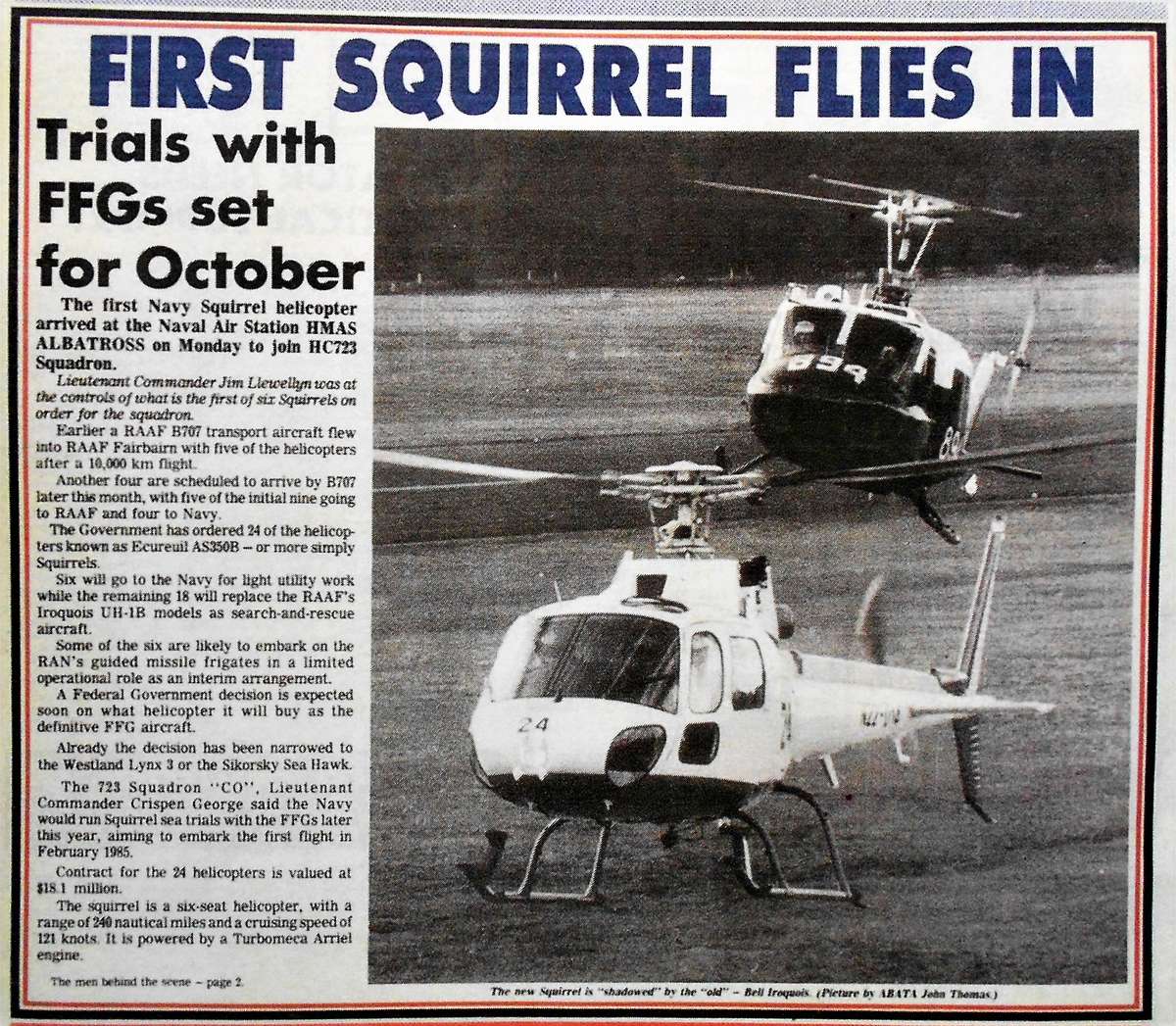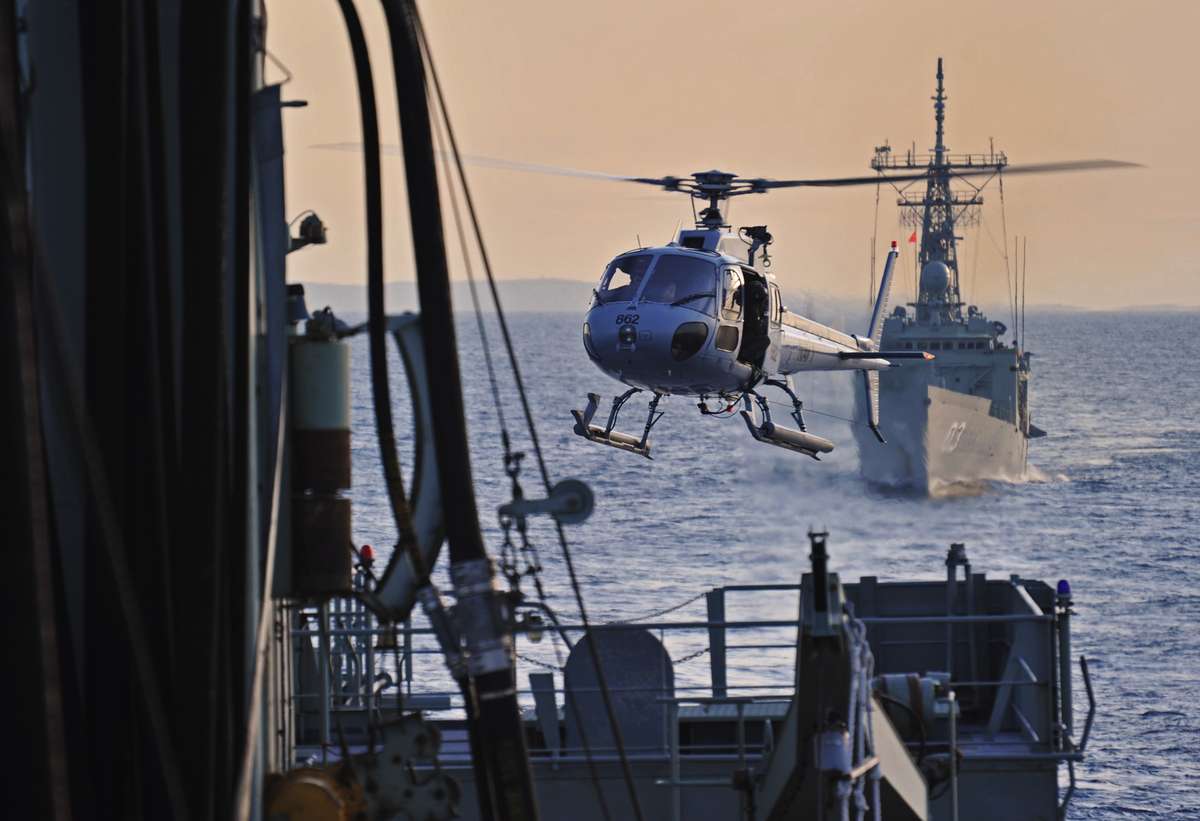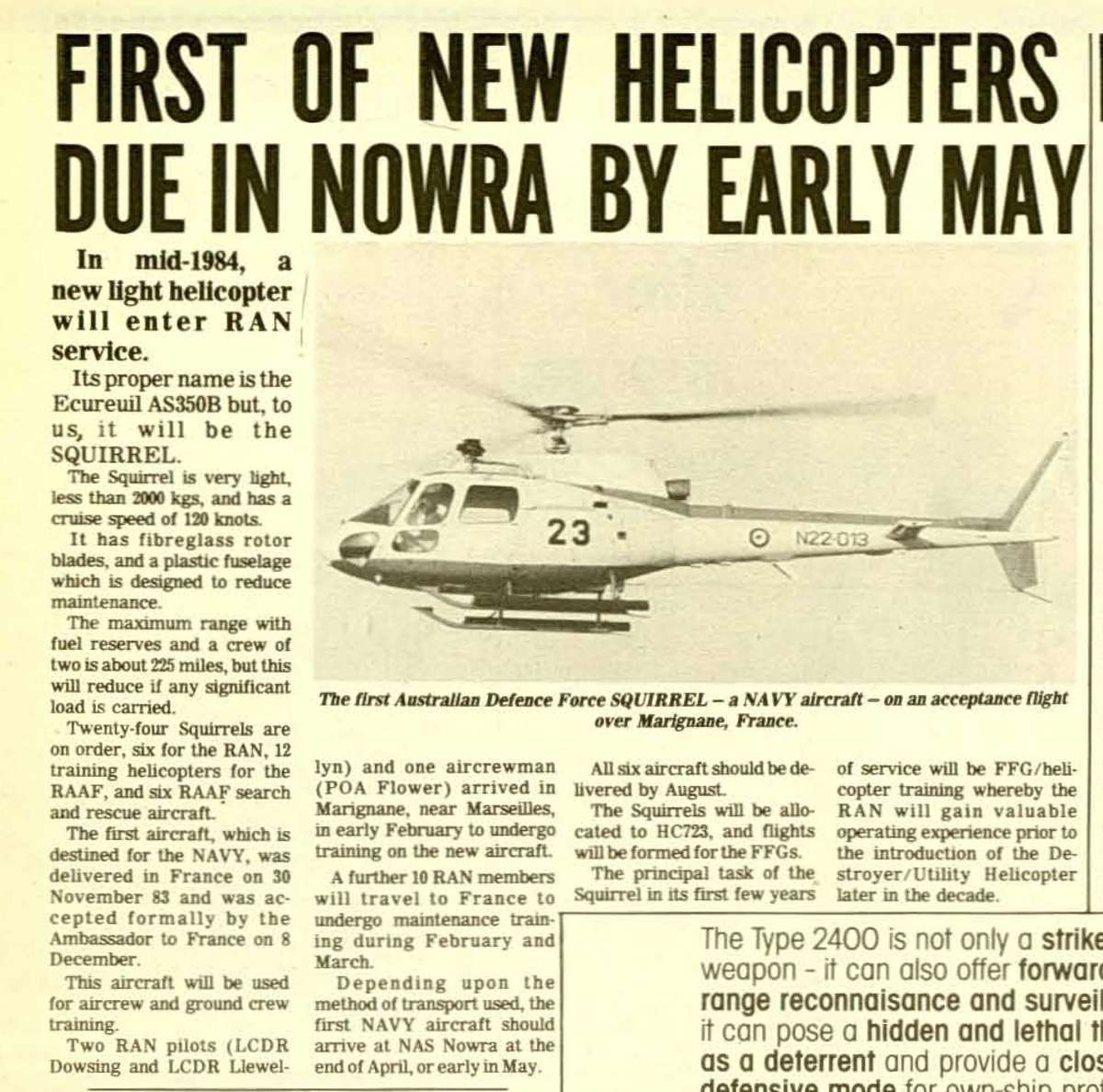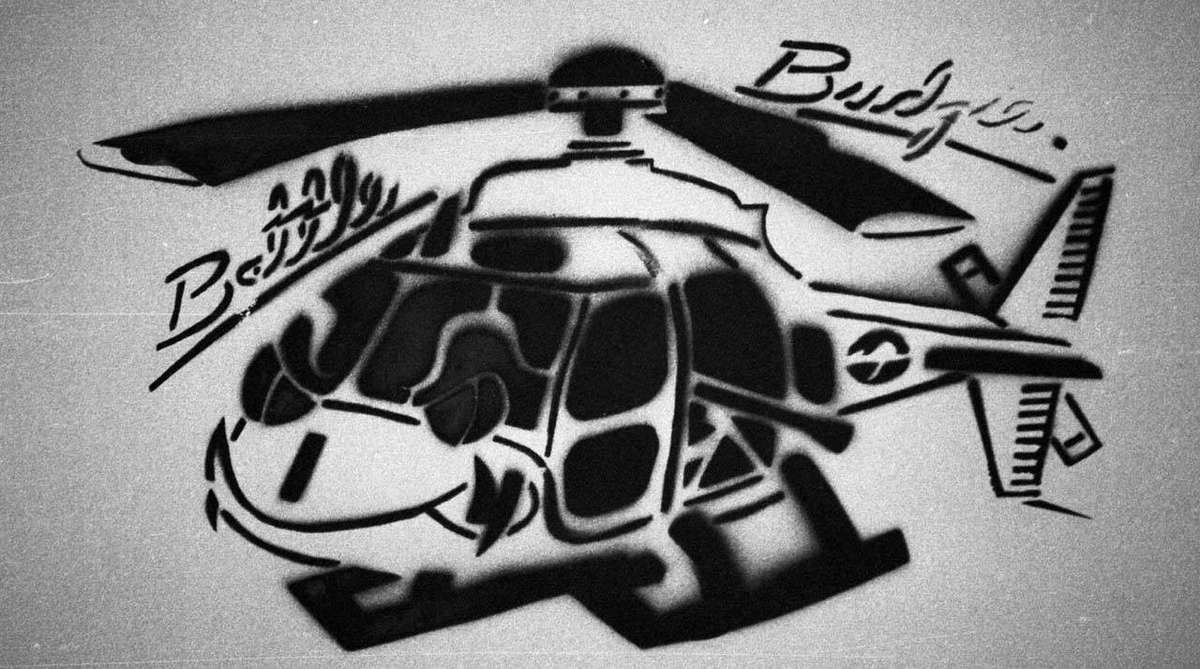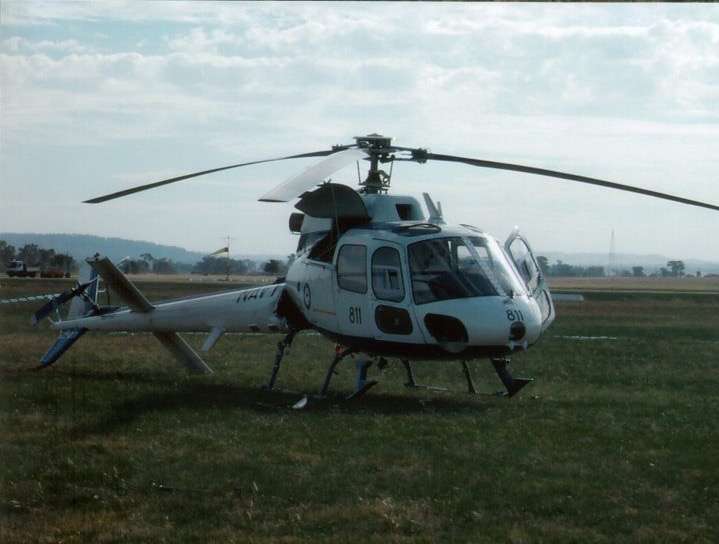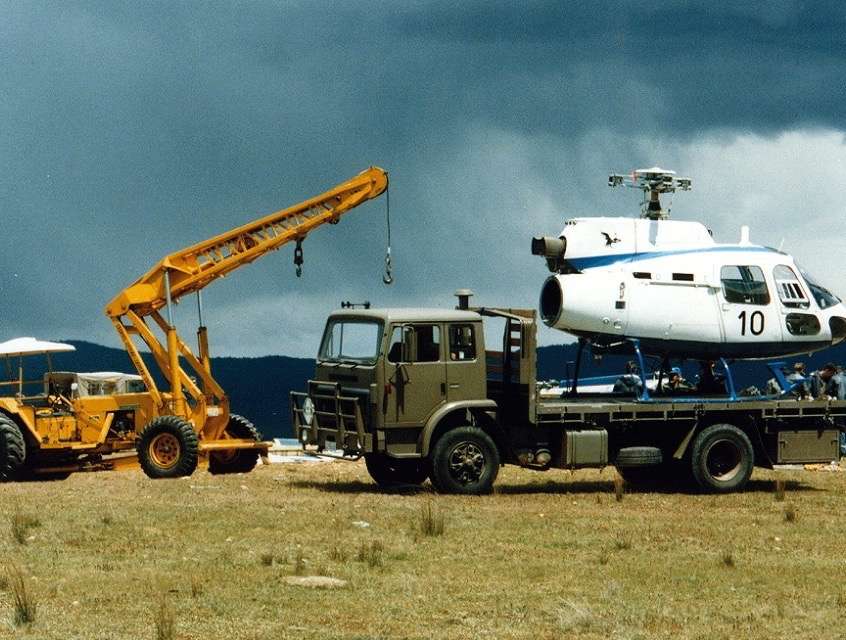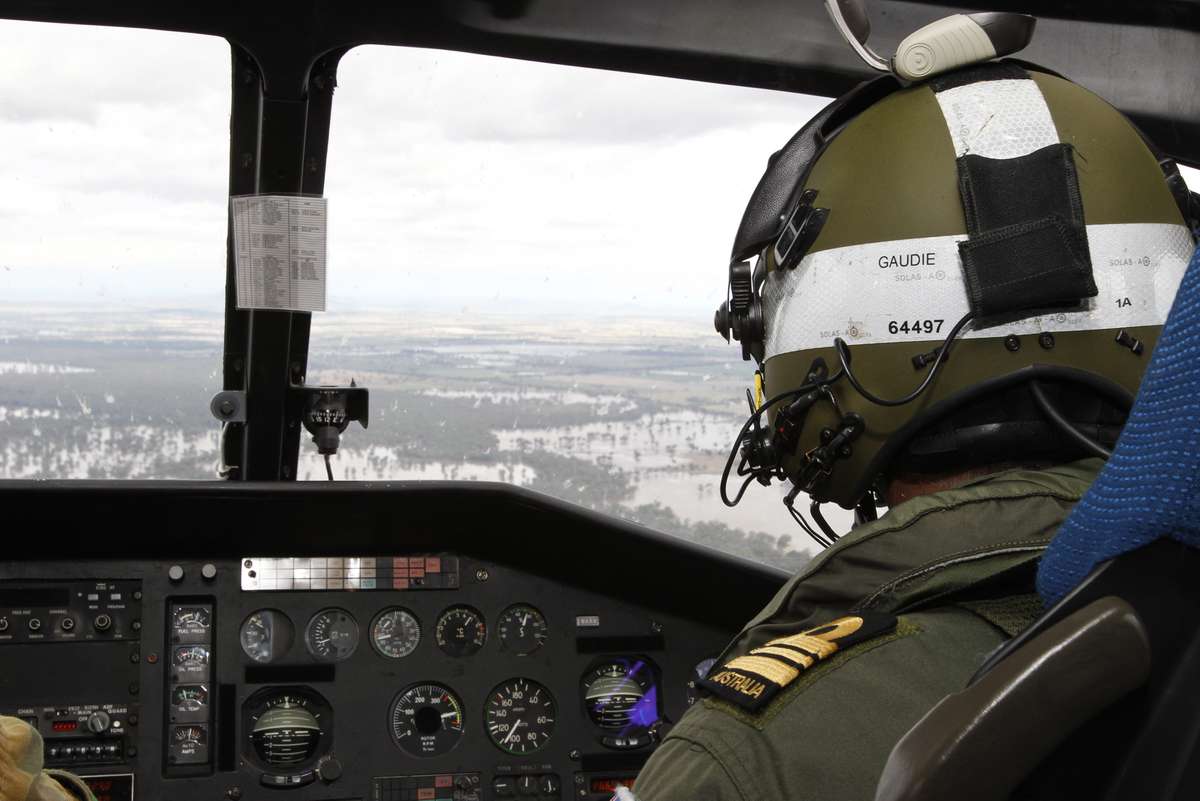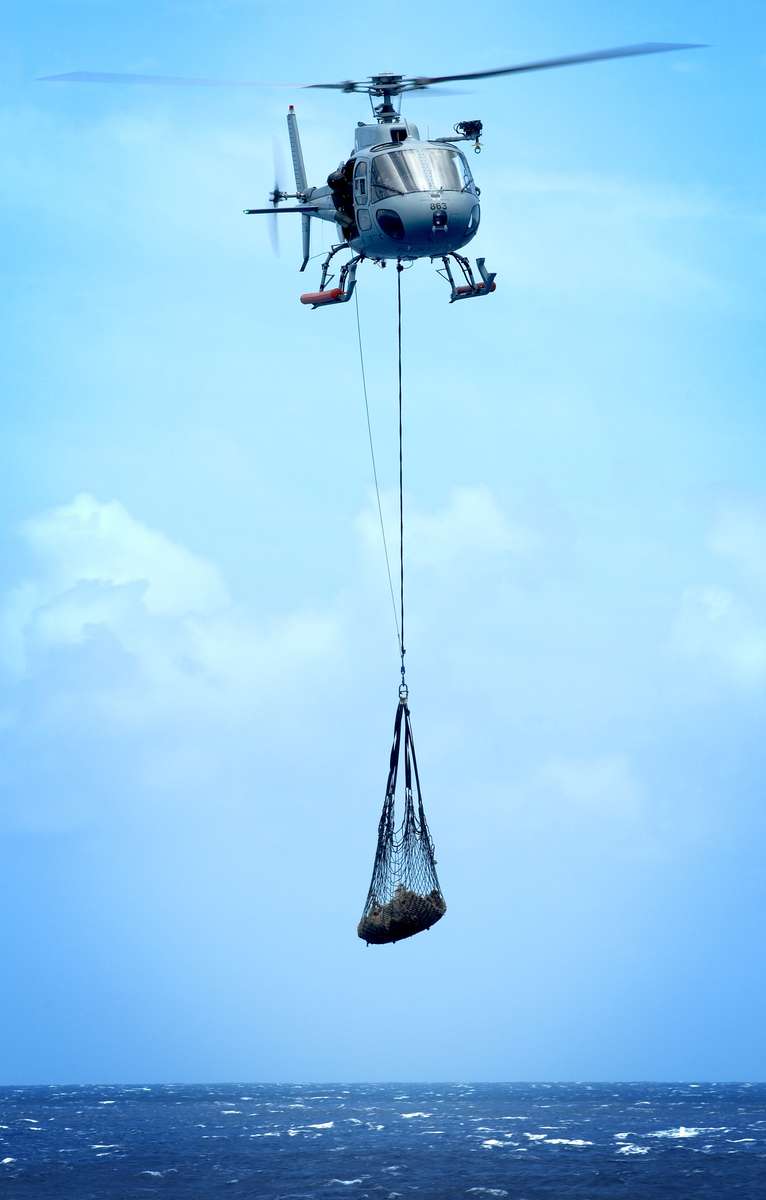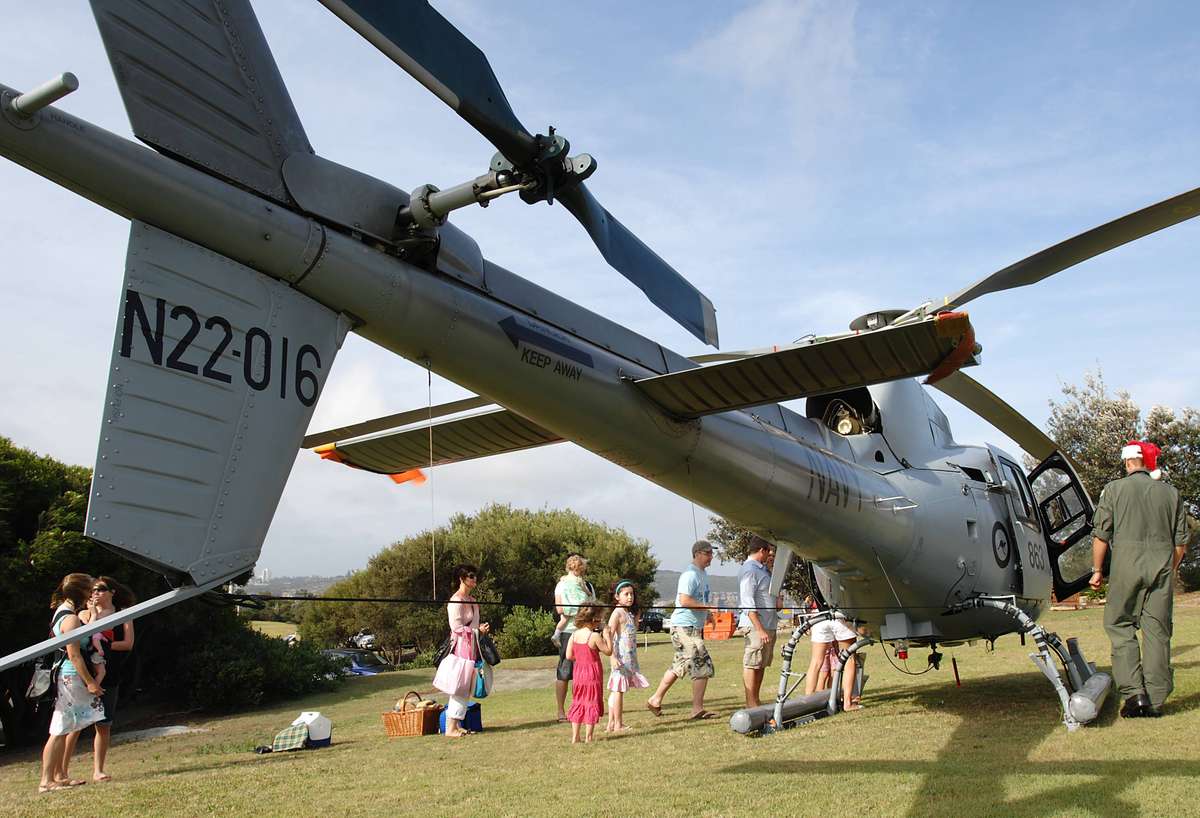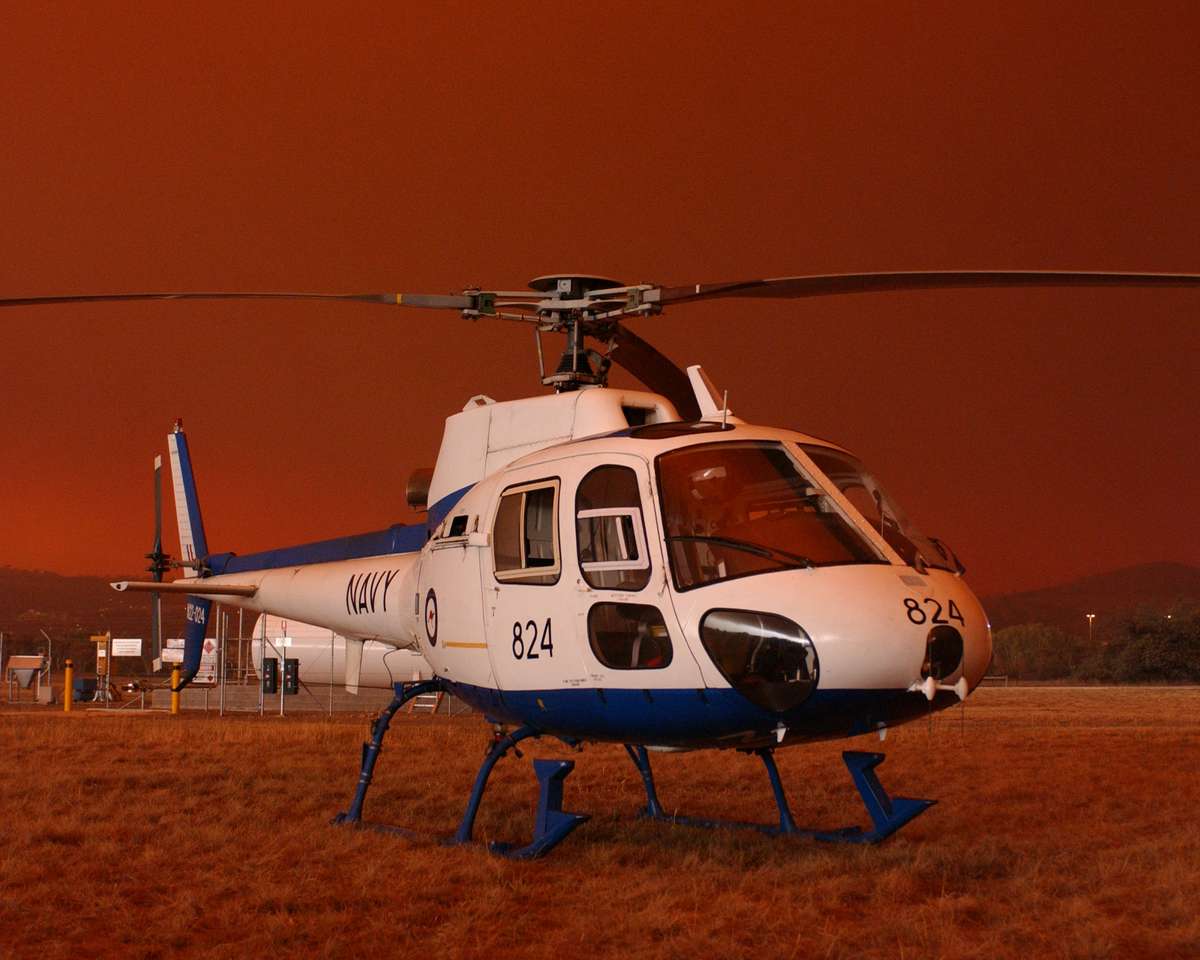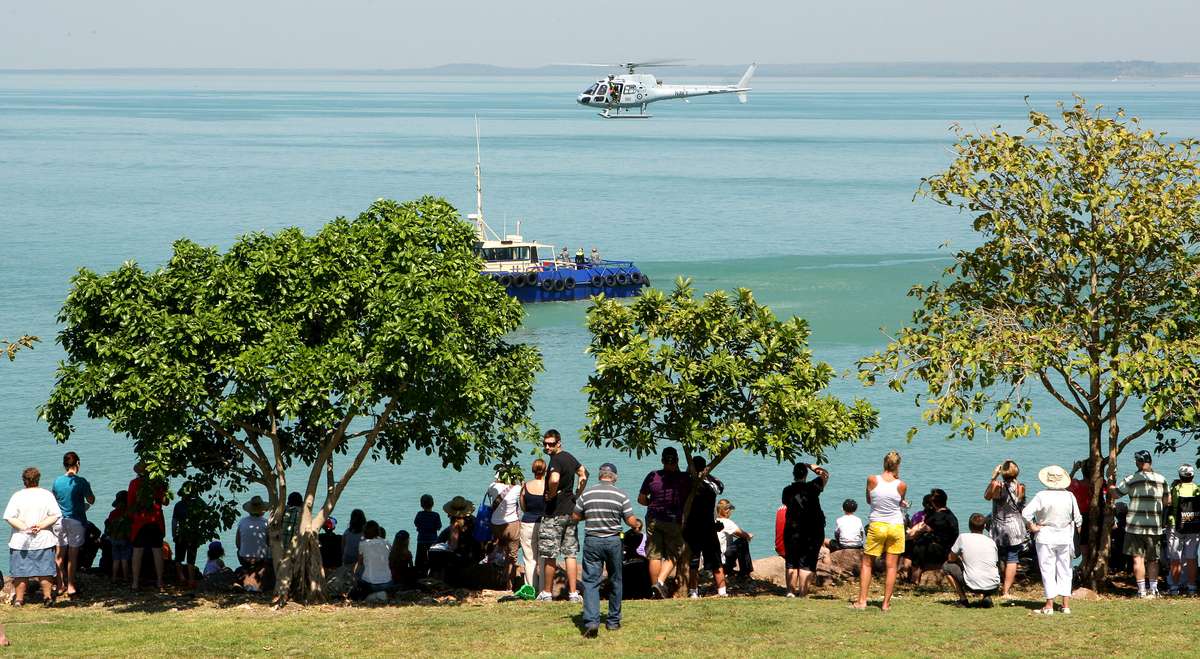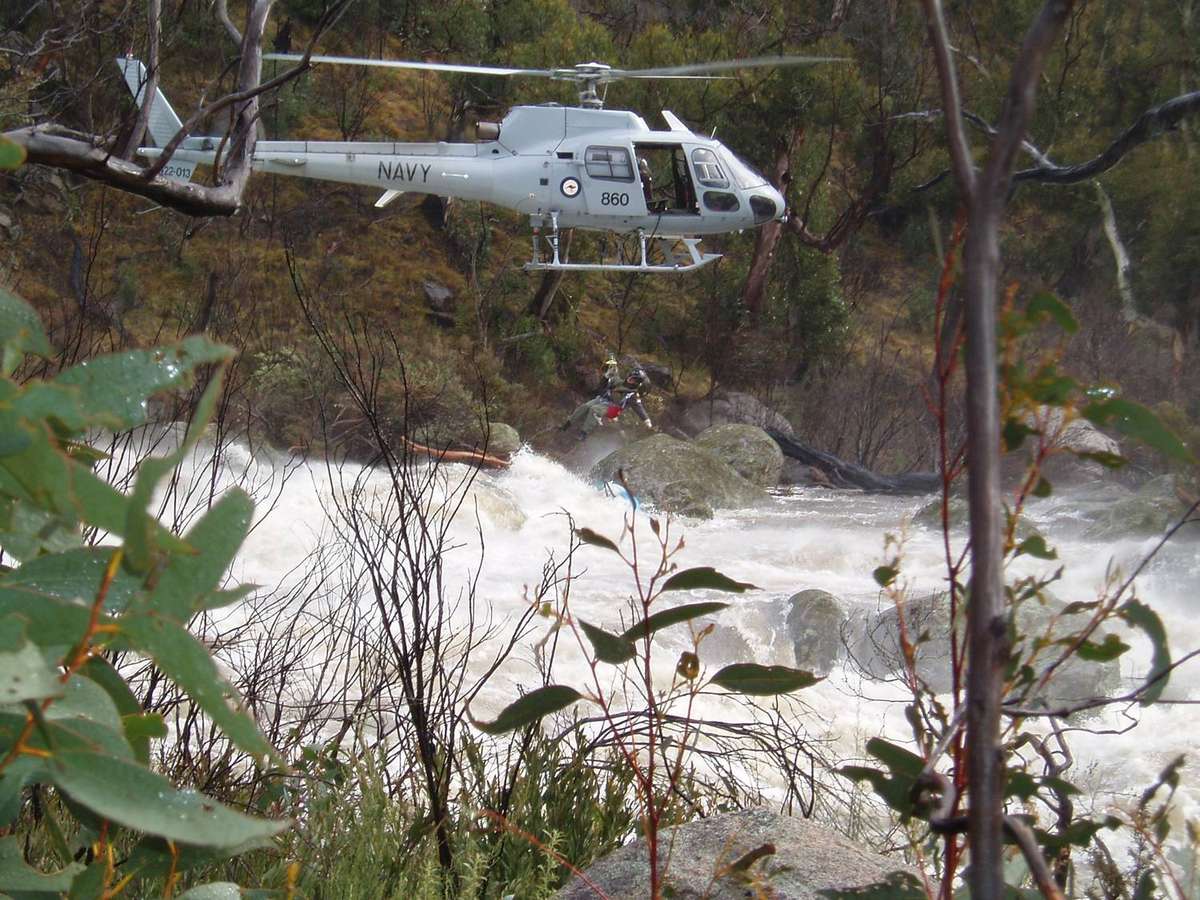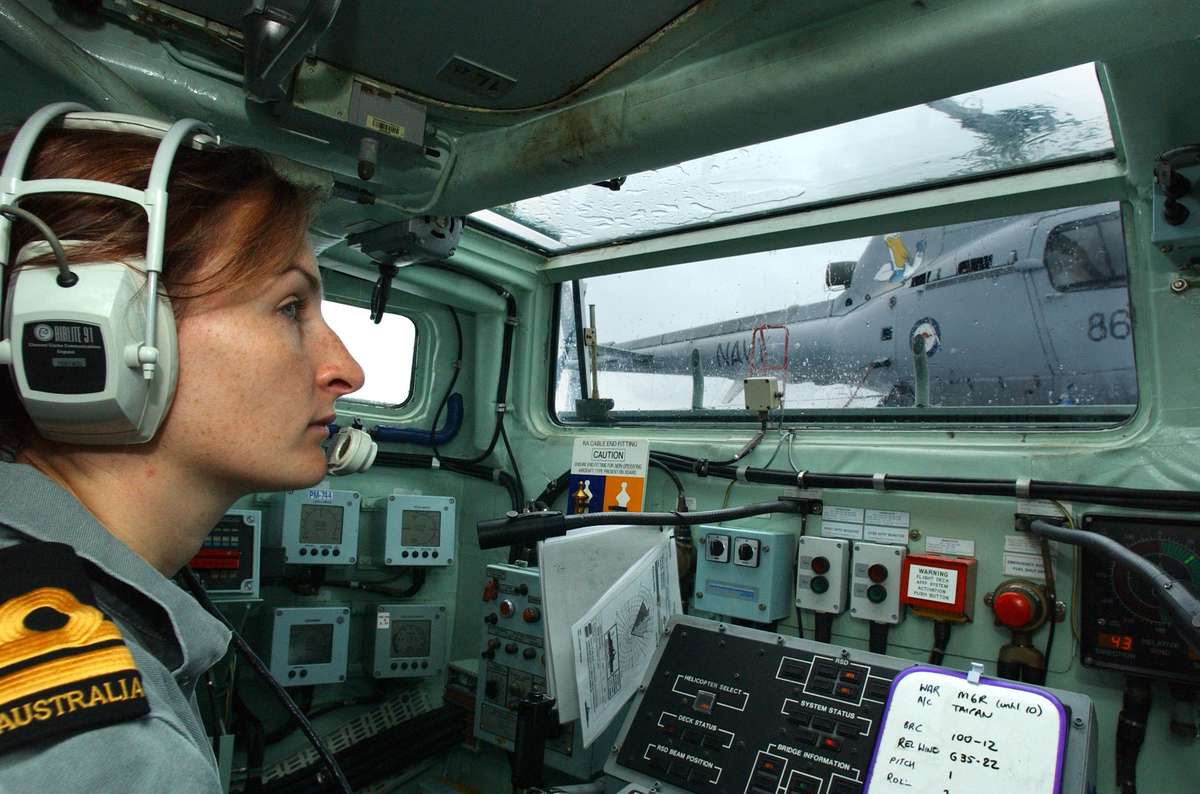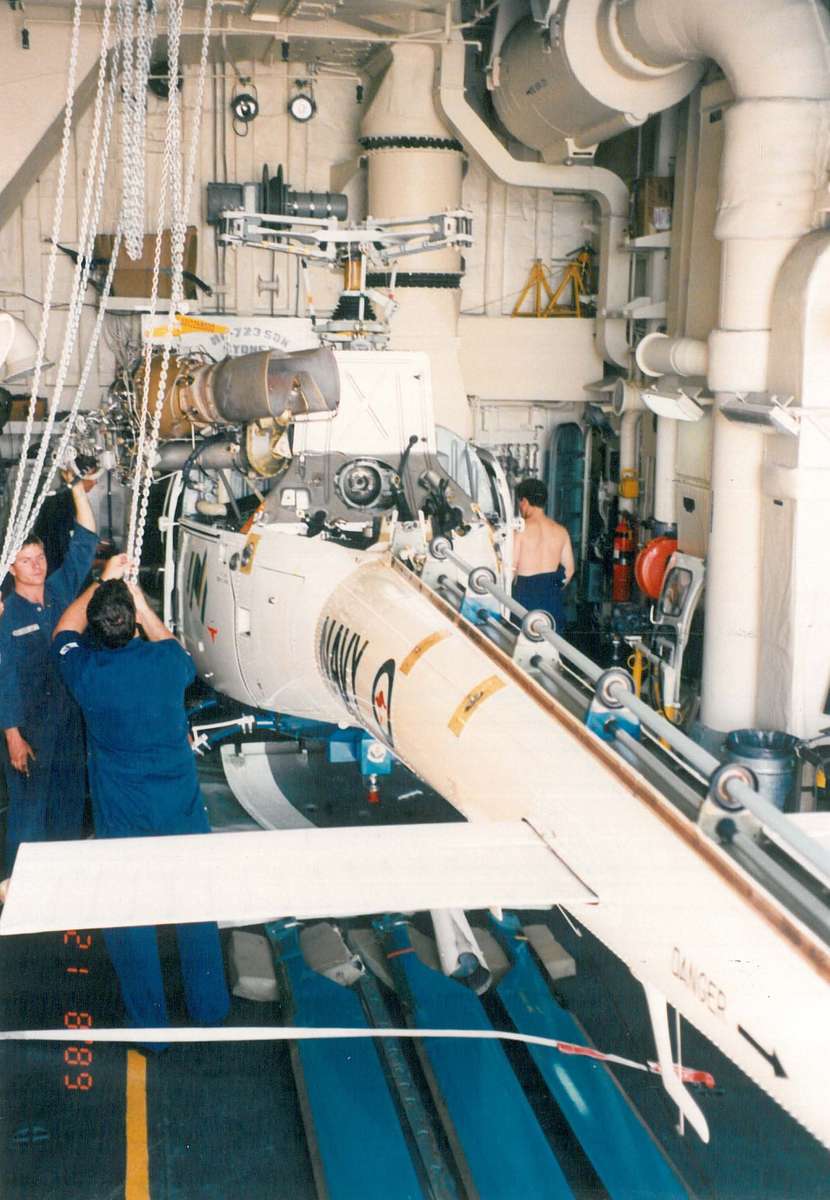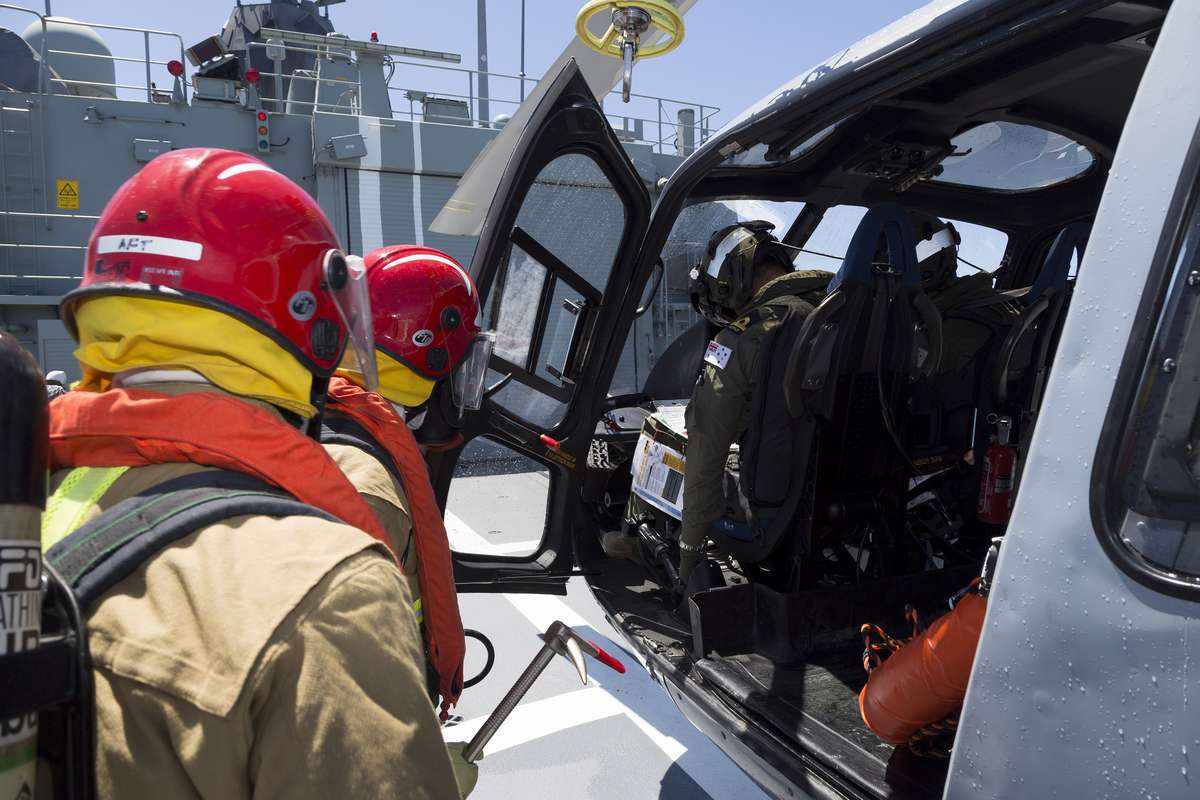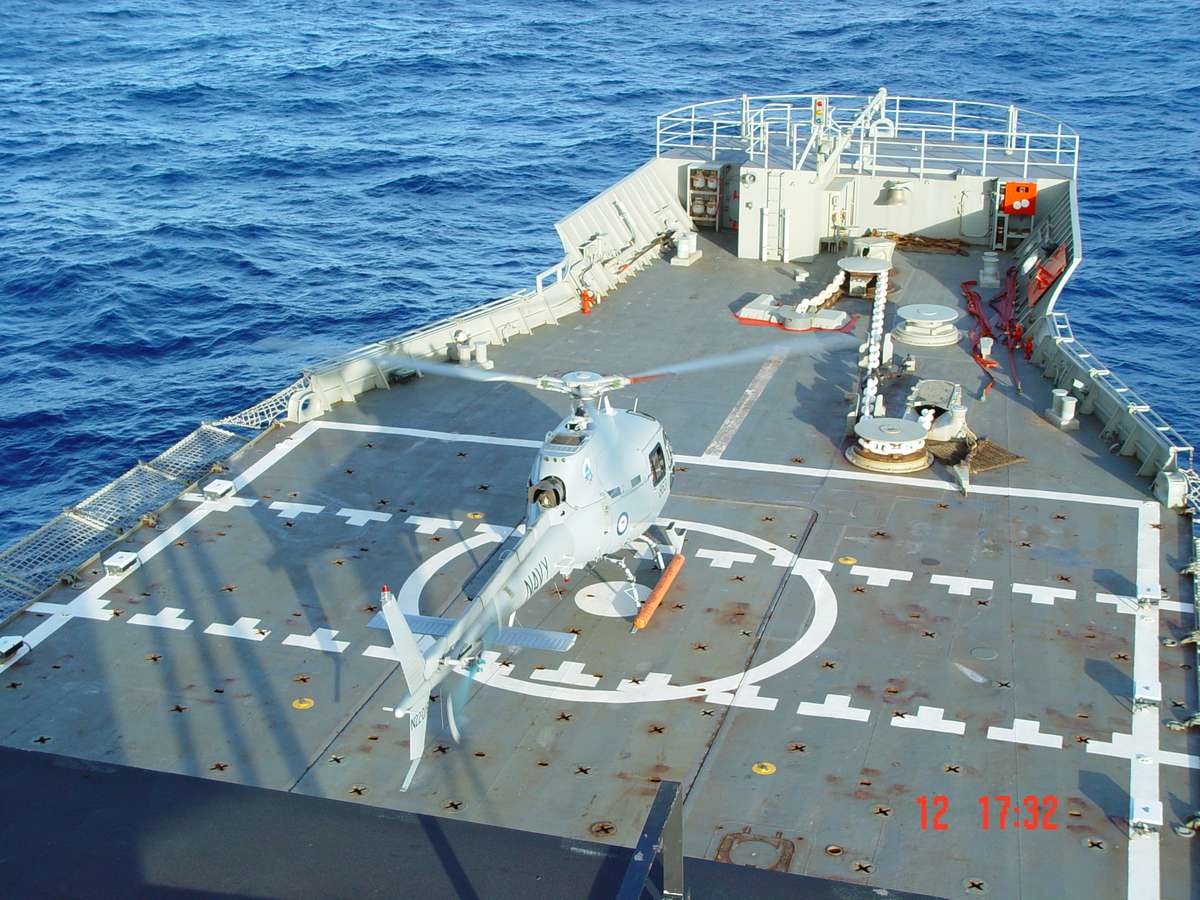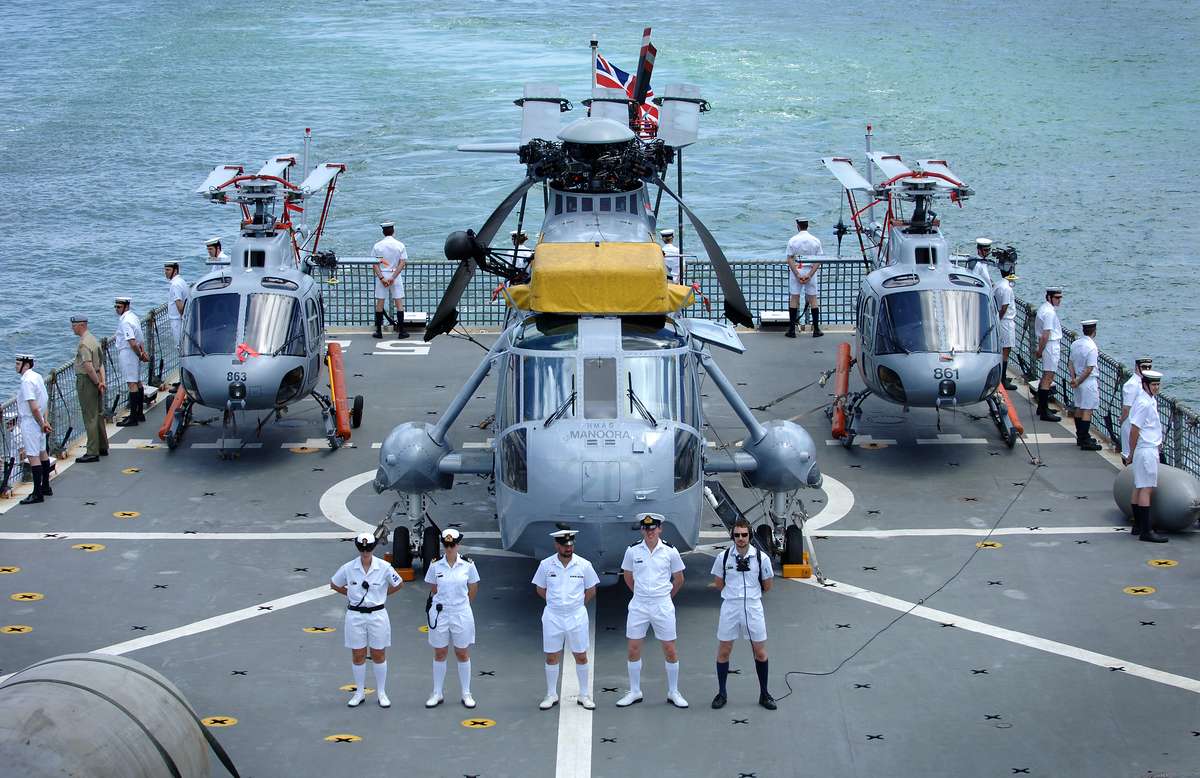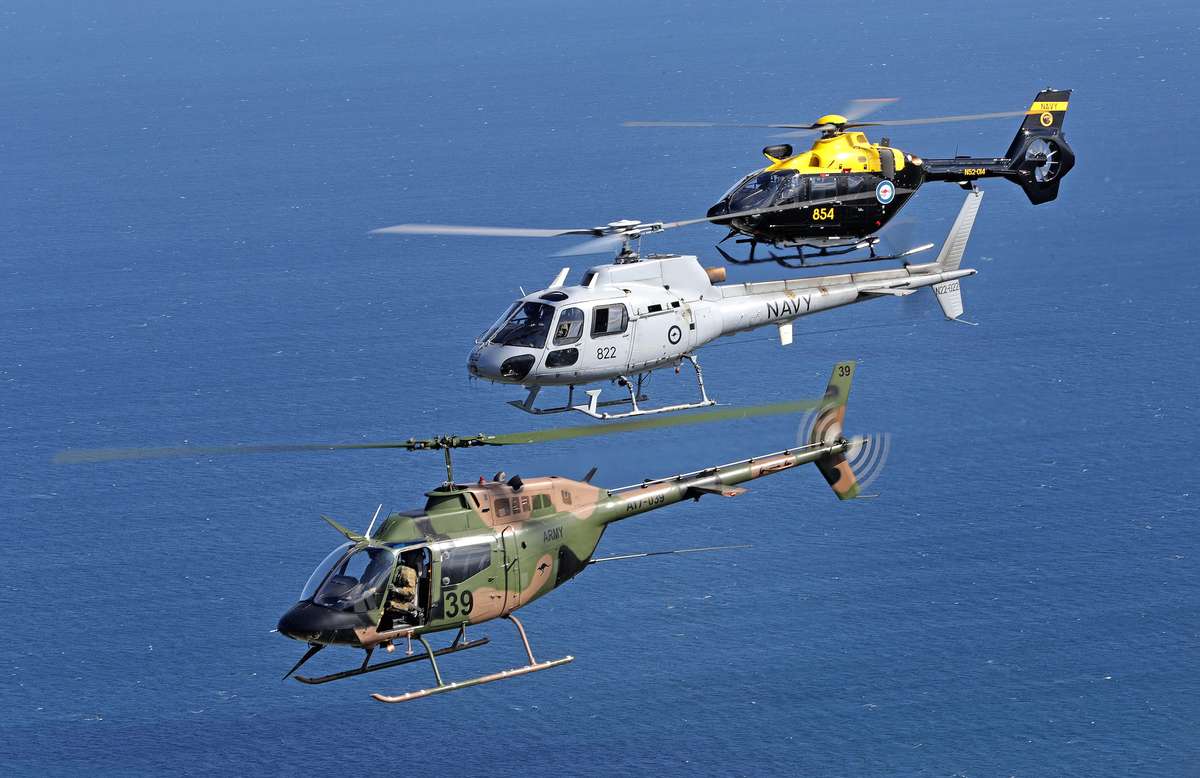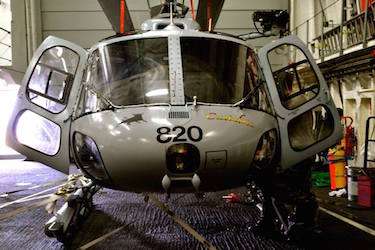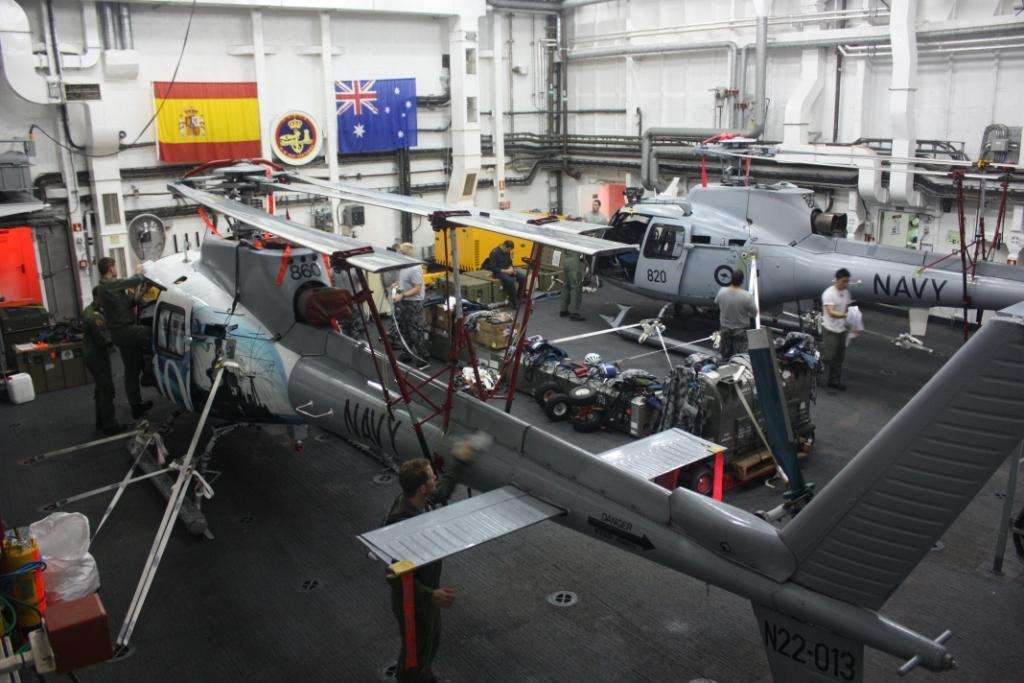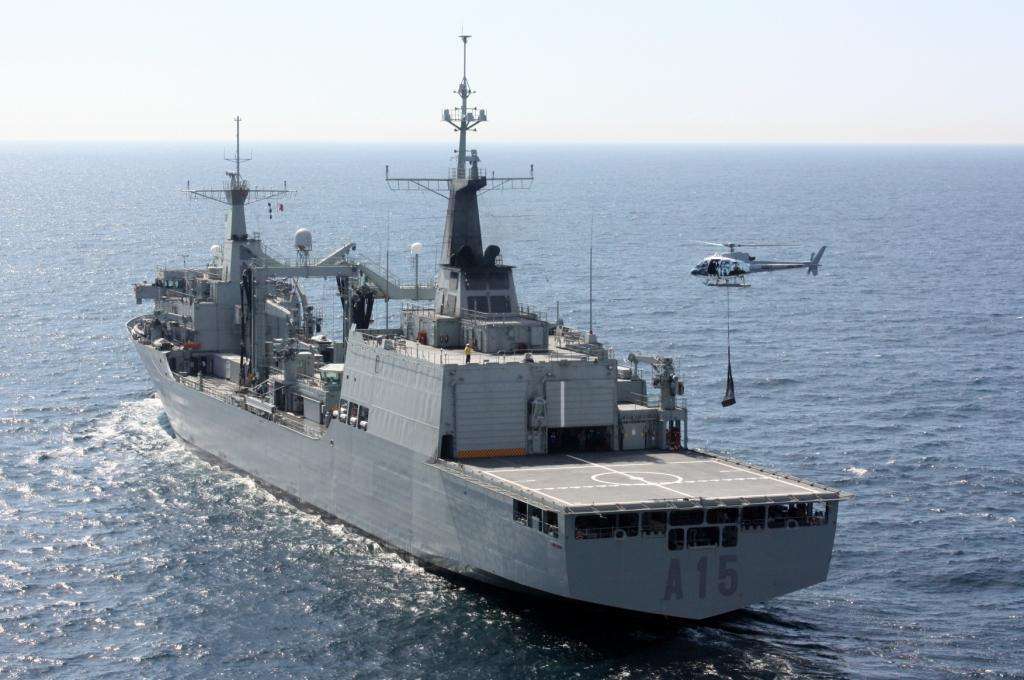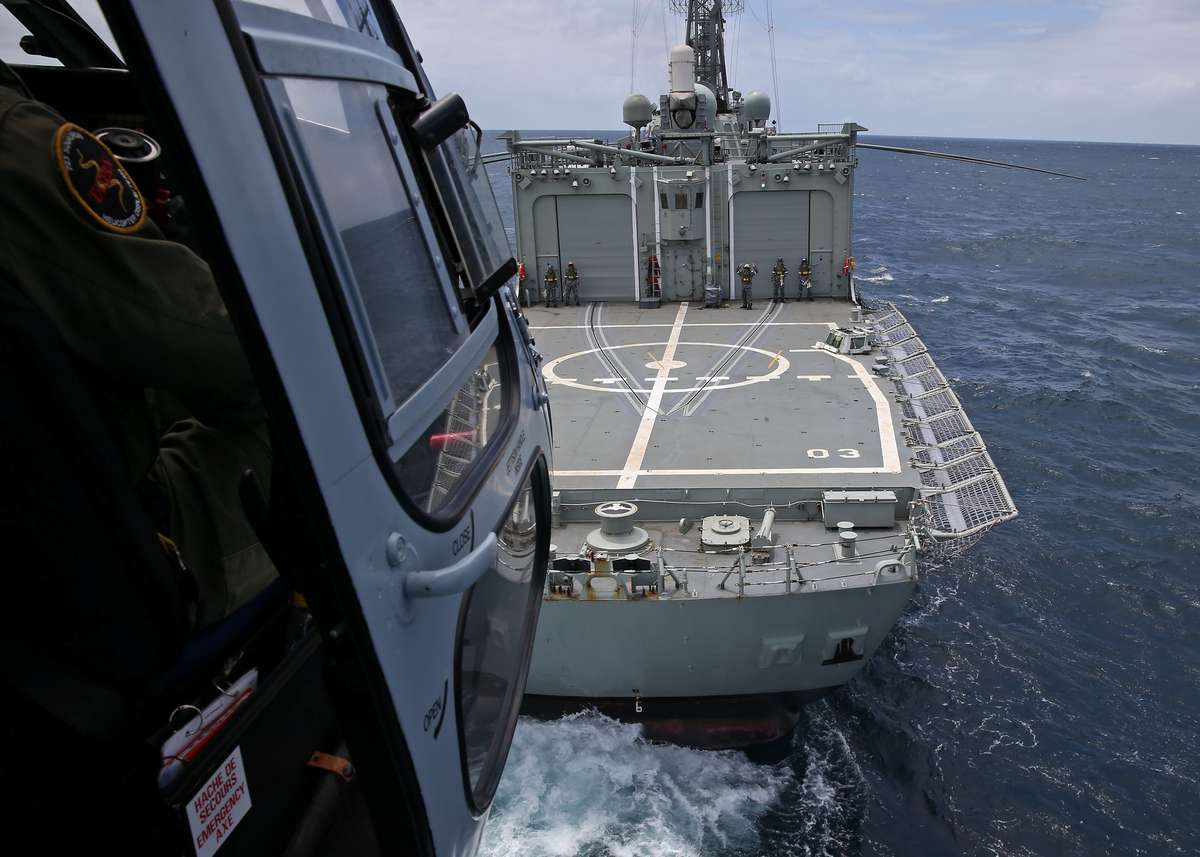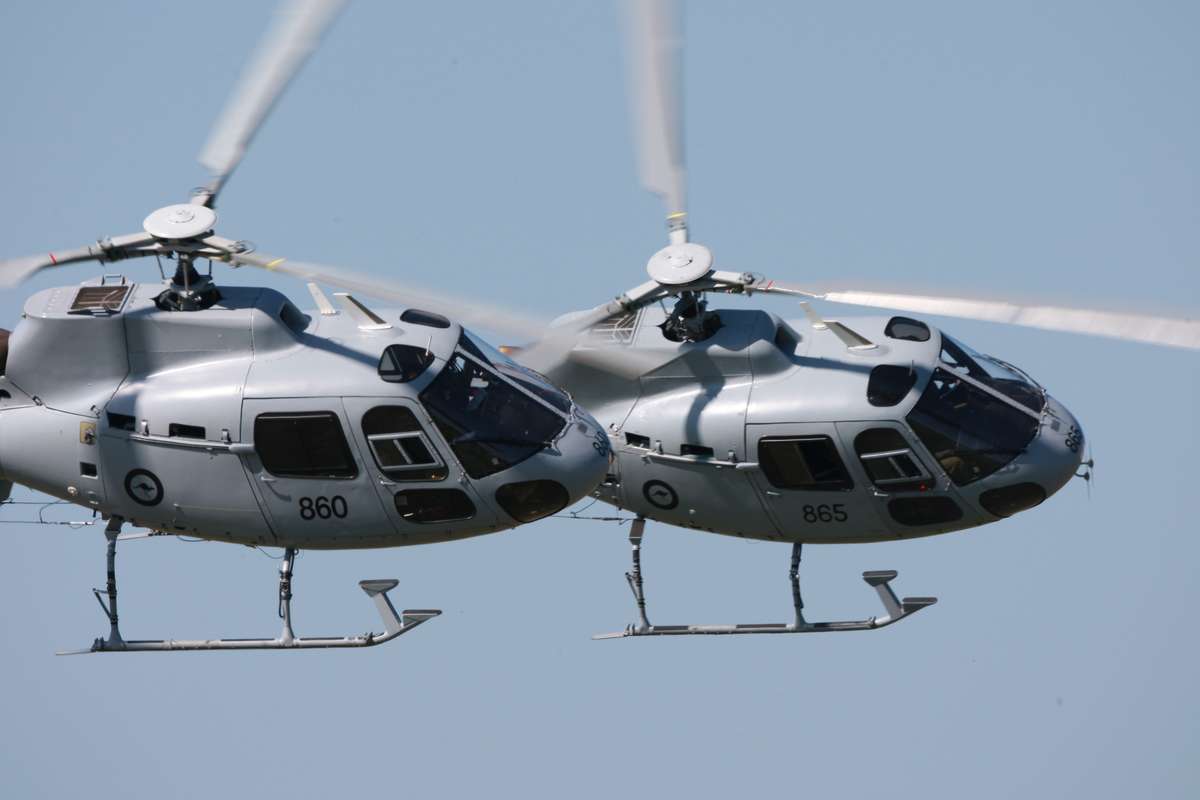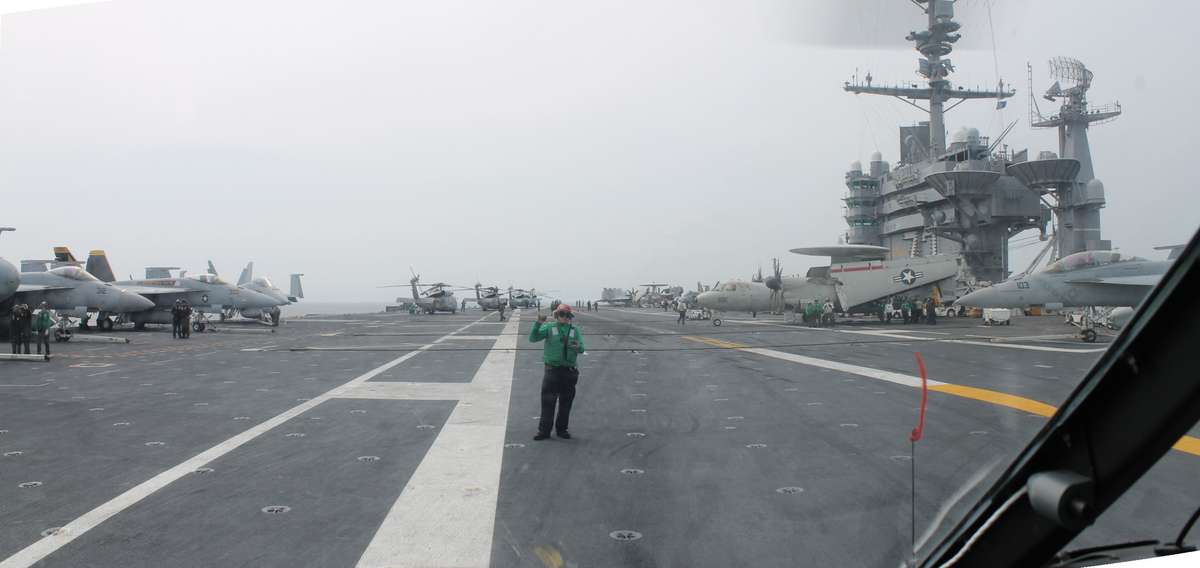Above left: Aircrew training in France, 28 February 1984. Brett Dowsing refuelling in the French Alps enrolee to Mont Blanc to prove the aircraft ceiling of 16,000 feet, and for mountain flying instruction. Jim Llewellyn and Guy Flower were also aboard, together with the French instructor Monsieur Daniel Le Ruste. (Photo: Brett Dowsing) Above right: The entire 723 Squadron Squirrel contingent in Marignane, France, for instruction on the AS350. Far left is the Aerospatiale liaison officer. Besides the aircrew mentioned in the LH photo, the contingent included Tim Wade, Dave Squillari, Dwane Unwin, Tony Emmitt, Andy Brownrigg and Steve Cottham. The hangar behind the Squirrel was previously used for airships. Feb 1984. (Photo: Brett Dowsing).
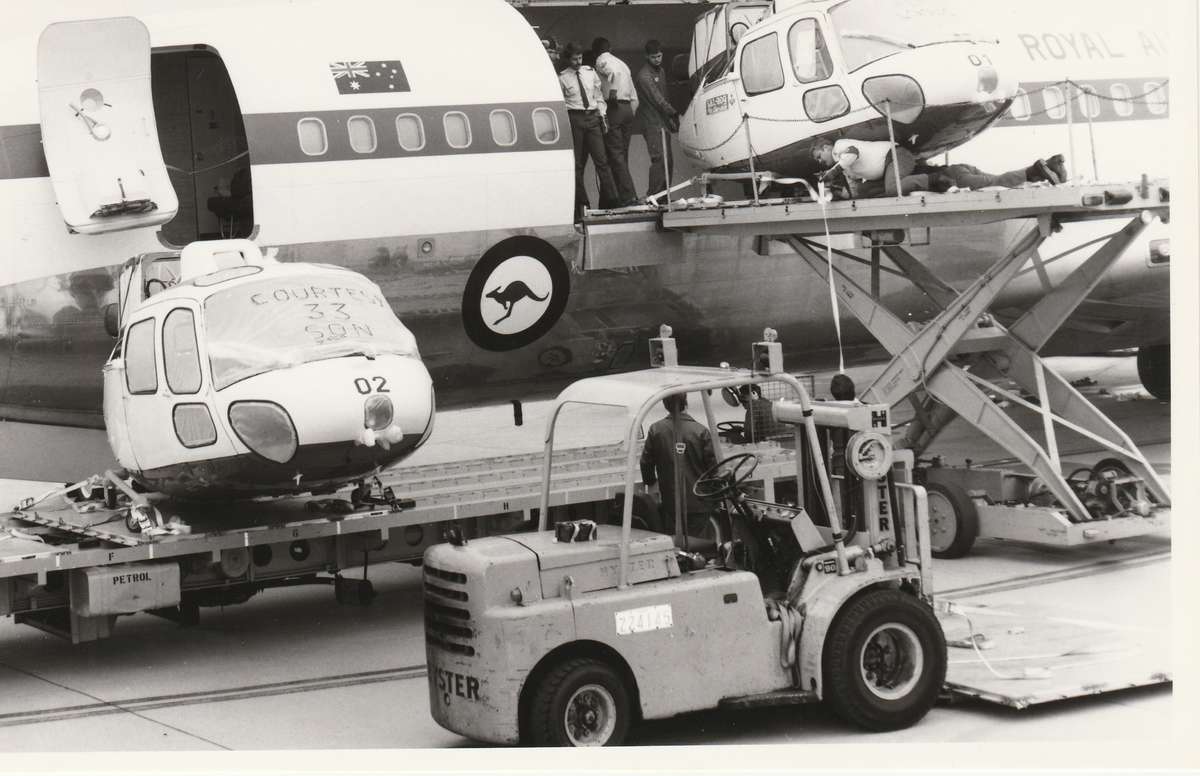 Above: May 1984 – the first five RAAF and RAN aircraft arrive at RAAF Fairbairn in a 33 Squadron Boeing 707. These aircraft were handed over at a ceremony at Fairbairn on 22 May. A further four followed by No 33 Squadron 707, then six by sea, with the remaining nine airlifted in late 1984. Below: A tight squeeze! Someone must have taken very careful measurements before committing a 707 to fly to France to collect these aircraft. The RAAF Loadmasters must have had some idle moments too, judging by the comments on the Squirrels’ windshields. (RAAF image from the Greg Davis collection).
Above: May 1984 – the first five RAAF and RAN aircraft arrive at RAAF Fairbairn in a 33 Squadron Boeing 707. These aircraft were handed over at a ceremony at Fairbairn on 22 May. A further four followed by No 33 Squadron 707, then six by sea, with the remaining nine airlifted in late 1984. Below: A tight squeeze! Someone must have taken very careful measurements before committing a 707 to fly to France to collect these aircraft. The RAAF Loadmasters must have had some idle moments too, judging by the comments on the Squirrels’ windshields. (RAAF image from the Greg Davis collection).
Left: The Right Honourable Bob Hawke, Prime Minister of Australia, takes a squiz at the new aircraft. The Squirrel pictured initially served at RAAF Fairburn in the ADF Helicopter School but was transferred to the RAN in October 2000 when that establishment closed (all rotary wing assets were removed from the RAAF and given to Navy or Army, but the latter chose to retain the Kiowa as its training helicopter). It remained in service until December 2017, when it was transferred to the RAF Museum at Point Cook – a fitting end to this remarkable little aircraft. Its 33 years of service to the Commonwealth was almost exactly three times longer than Bob Hawke’s.

Although the Squirrel was never bought for embarkation duties, the lack of an alternative helicopter meant they must adapt to the task. Here the flight deck team of HMAS Warramunga remove lashings prior to take off. The rail visible in the deck is part of the tethered landing system for the Seahawk, which made its appearance some years after the AS350 was introduced. Squirrels had no such landing aids. (RAN image).
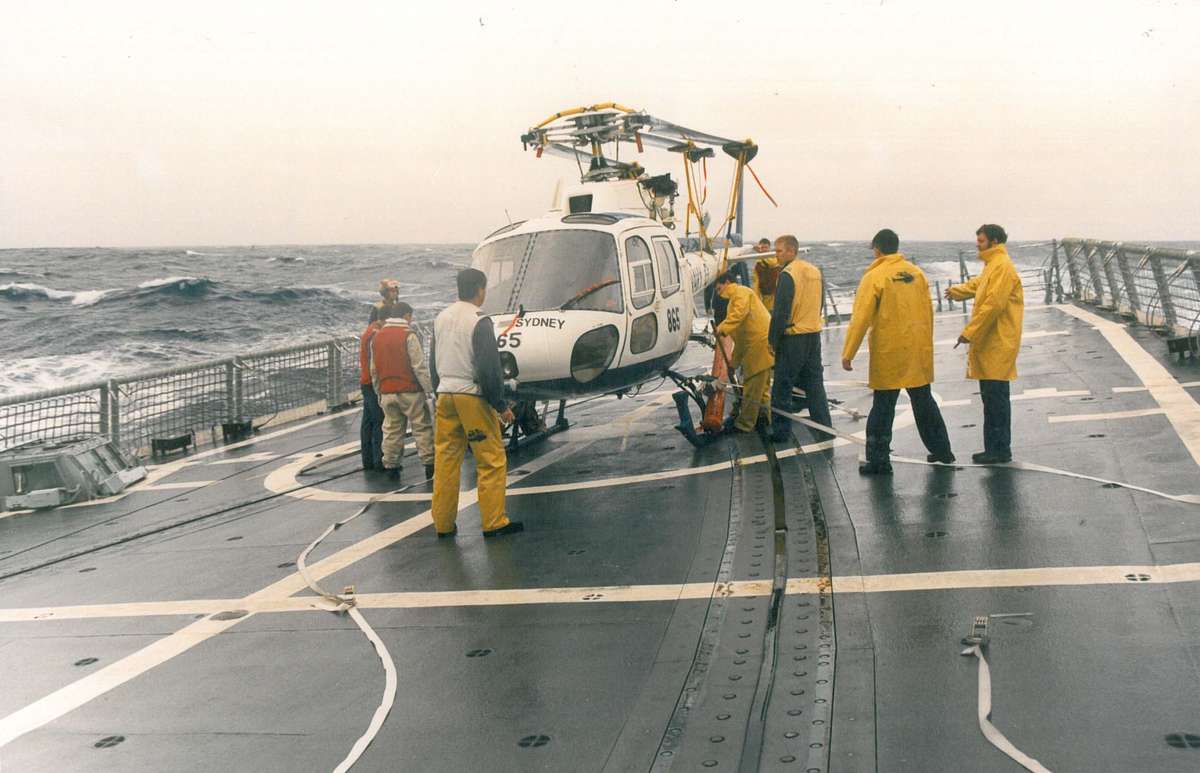 Another photo of deck operations, in an earlier time than that on the left (note the blue and white training livery). The aircraft is configured for movement into the hangar: the blades are secured and the flotation bags rotated, prior to engaging the ground handling wheels. Deck movements, especially in any kind of sea state, could be hazardous. Nylon lashings have been applied which will be progressively moved as the aircraft approaches the hangar. (Image via Jeff Chartier).
Another photo of deck operations, in an earlier time than that on the left (note the blue and white training livery). The aircraft is configured for movement into the hangar: the blades are secured and the flotation bags rotated, prior to engaging the ground handling wheels. Deck movements, especially in any kind of sea state, could be hazardous. Nylon lashings have been applied which will be progressively moved as the aircraft approaches the hangar. (Image via Jeff Chartier).
Below. Considering the Squirrel was in service for 30 years there were very few accidents, and none involving injury to aircrew. 811 was reportedly written off when it entered ground resonance at RAAF Wagga. 810, pictured here being transported on a truck, was damaged in an unspecified accident – possibly at Cooma when the pilot’s glove snagged the hydraulic on/off switch and a heavy landing resulted. Photos via Jeff Chartier.
Below left 1-5. For an aircraft that was bought specifically for training, the Squirrel proved to be remarkably versatile. Aside from its embarked duties the aircraft performed a variety of tasks: [1] Undertaking Flood Relief duties near Wagga in March 2012. [2] Vertical replenishment to HMAS Manoora. [3] SAR Diver training, probably in Jervis Bay near Nowra. [4] Public Relations is never far from the Navy’s mind: here a Squirrel acts as Santa’s sleigh near HMAS Watson, performing to a crowd of about 1500 people, and [5] set against a crimson sky, this Squirrel has been engaged in bush fire support operations. Click on any image to expand. (RAN Photos).
Above: A Royal Australian Navy Squirrel Helicopter decorated with International Fleet Review colours flies past the Sydney Opera House on 27 June 2016. The RAN was testing its new Three Pound Saluting Gun Battery at the GI Naval Base in readiness for the IFR in October of that year. A Seahawk S70B flying a large IFR flag was also present, out of the image. (RAN photo). The complex IFR design was not actually painted on the aircraft, but applied as a decal to four Squirrels involved in the Review. The two small images above right (click to enlarge) show staff from ‘Fleeting Image’ applying the decal to one of the aircraft. (RAN photos). Below. One of the IFR decorated Squirrels engaged in a sling loading exercise, possibly for Staff Training. The crewman checks below the aircraft whilst the pilot holds it in a low hover. (RAN image).
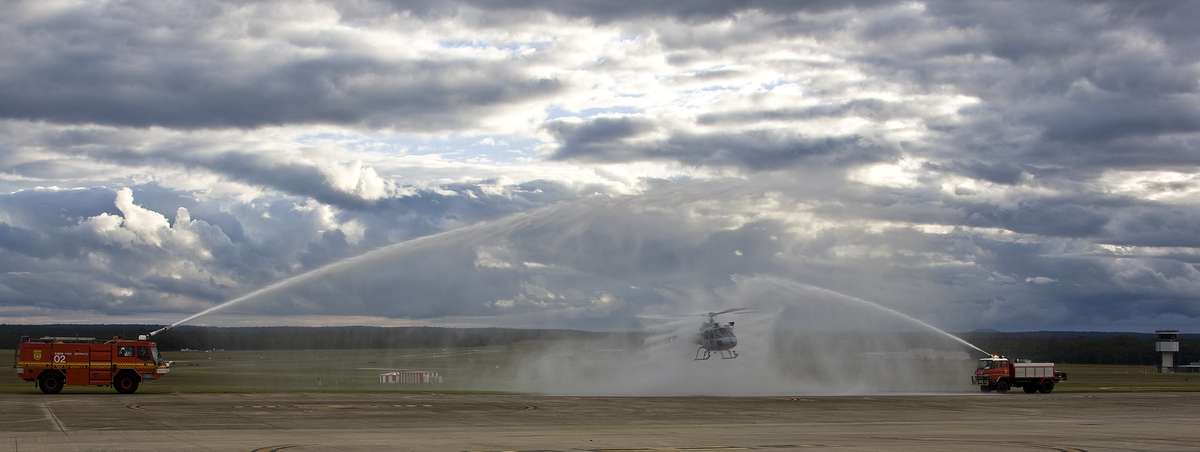
Above: CMDR Colin Brightling, the then Commanding Officer of HC723 Squadron, is afforded the traditional salute for his last flight in a Squirrel prior to relinquishing Command. The vortices from the rotors can be clearly seen. This panoramic image captures early morning over HMAS Albatross. (RAN image).
Right: This photo gives a different perspective on deck operations. It shows LEUT Rebecca Levitt in the helicopter control room of HMAS Warramunga as the Squirrel helicopter is launched. She would be responsible for liaising with the Bridge to ensure the ship was on a flying course and it is safe to recover or launch the aircraft (you can see the Ship’s Helicopter Operating Limit diagram stowed on its side, low in the centre of the image. The SHOAL sets out the wind/deck to which this aircraft type is cleared, and is derived from flying trails on the deck when the class of vessel is introduced). She would also, of course, be in contact with the pilot and give instructions to the flight deck crew. (Navy image).
Below, clockwise from left: [1] A Flight maintenance team conduct an engine change on a Squirrel. [2] Crash on deck! Fire and rescue parties are present at every take off and landing. Here they practice a crash on deck, where the aircrew simulate being disabled. [3] A Squirrel on the forward deck of HMAS Manoora. Normally this flight deck is used for vertical replenishment or perhaps storage of aircraft or other vehicles in transit. [4] Over its thirty years of Service, the Squirrel shared the sky with a wide variety of other ADF rotary wing aircraft. Here, two AS350BAs are ranged on HMAS Manoora’s flight deck with a Sea King Mk 50. The ship is at procedure Alpha as she enters Pearl Harbor. [5] A Squirrel in formation with the training aircraft it replaced (the Kiowa, shown here in Army livery) and the one that replaced it: the Eurocopter EC-135. (RAN images)
Below: As seen through a fish-eye lens, two Squirrels together with relief/maintenance crews and RAAF loadmasters sit out the long flight from Nowra to Darwin for Exercise Triton Thunder. This shot, taken by a Navy photographer, captures both the diminutive size of the AS350BAs and the large size of the C-17’s cargo deck. We understand it was the first time that AS350s had been aboard the Globemaster. (RAN image).
 Above: Not just an ordinary group photograph – this one has real historical significance. On 3 July 2012, the Australian and Spanish governments signed an agreement to deploy the supply ship ESPS Cantabria in support of the Royal Australian Navy during 2013. The ship operated in Australian waters from February to November 2013, was used to provide replenishment support to the Australians while the oiler HMAS Success underwent maintenance. The arrival of two AS350BA Squirrel helicopters of 723 Squadron on the flight deck of Cantabria signalled a significant moment in history for both the Armada and the Royal Australian Navy; the first occasion of a foreign helicopter Flight embarkation for both Navies.
Above: Not just an ordinary group photograph – this one has real historical significance. On 3 July 2012, the Australian and Spanish governments signed an agreement to deploy the supply ship ESPS Cantabria in support of the Royal Australian Navy during 2013. The ship operated in Australian waters from February to November 2013, was used to provide replenishment support to the Australians while the oiler HMAS Success underwent maintenance. The arrival of two AS350BA Squirrel helicopters of 723 Squadron on the flight deck of Cantabria signalled a significant moment in history for both the Armada and the Royal Australian Navy; the first occasion of a foreign helicopter Flight embarkation for both Navies.
723 Sqn Cantabria Flight, consisting of two aircraft and 25 personnel, was the culmination of months of hard work by both Navies, and was an exemplary example of the co-operation between Cantabria and the RAN during her 2013 Australia deployment.
In total, ten junior aircrew were been trained in the disciplines of Deck Landings, Vertical Replenishment (VERTREP), Transfers, and Anti Surface Warfare (ASuW). Significant experience was also gained by the maintenance personnel, with this detachment being the first time that the majority of them had been a member of a Flight at sea. Although the focus of flying operations was centred around gaining Embarked Qualifications, the detachment also had a strategic goal of proving integration and operations utilising Standing NATO Agreement 1470 which provides guidance for the embarkation of one nation’s helicopter(s) in that of another nation’s ship.
Below Left: A Squirrel bearing a fanciful ‘Cantabria’ name and El Toro bull image sits in the port hangar of the vessel. Centre: the size of the ship meant plenty of room for maintenance. Right: A Squirrel in IFR colours about to drop a sling load on Cantabria’s Flight Deck. (All images RAN).
Below: Aircrewman’s view! HMAS Sydney’s embarked Squirrel aircraft approaches the flight deck for landing during their North and South East Asia Deployment. The FDO is indicating the aircraft should move forward and the four lashing numbers wait for it to land before moving in to secure it. The fire party remain out of sight but are ready for any mishap such as a crash on deck. (RAN image).
Right: Squirrel Helicopters from HC723 Squadron’s ‘twin pairs’ display team at the 2008 Defence Air Show, Amberley. These helicopters performed at air shows and other events around the country and were always a popular event. The 2008 Defence Air Show took place at RAAF Base Amberley and featured flying and ground displays involving aircraft from the three Services, the United States Air Force, United States Marines, Warbirds, and some commercial contractors who directly support regional Australian Defence Force (ADF) activities. (RAN image).
Below. Another shot of the Flight Deck of the USS Independence, upon which an AS350 landed to pick up a spare part for the ship’s Seahawk. It would be unusual for the Indy to host such as small helicopter. (Image via Jeff Chartier).
Left. We have seen few photographs of the GPMG that RAN Squirrels were fitted with during their Middle East deployments, but here is one. We have asked for more information about the fitting and the general utility/limitations on use and will report back when known. If you can tell us anything, use the “Contact Us” form below.
Do you have any Squirrel photographs you could share with us? We are after good quality images that tell something about the aircraft or the people who operated and maintained it. In particular, images of maintenance procedures and operational experience (e.g. whilst engaged in the MEAO) would be most welcome. Simply use the ‘Contact Us’ box below to advise.
History of the RAN Squirrel
AS350 & S70B Retirement Ceremony Dec 2017

